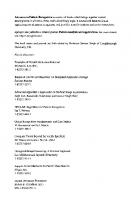Developing and using pattern recognition
Do you find yourself getting drawn into the game of predicting market trends? Are you awash with newsletters, TV program
545 17 83KB
English Pages 4 Year 1989
Recommend Papers

- Author / Uploaded
- Johnson T.
- Boucher M.
- Similar Topics
- Computers
- Algorithms and Data Structures: Pattern Recognition
File loading please wait...
Citation preview
Stocks & Commodities V. 7:10 (362-364): Developing and using pattern recognition by Tom Johnson and Mark Boucher
Developing and using pattern recognition by Tom Johnson and Mark Boucher
D
o you find yourself getting drawn into the game of predicting market trends? Are you awash with
newsletters, TV programs and news stories about "gurus" calling the markets? Such crystal ball gazing is often idolized by the media. But does sorting bulls from bears help your bottom line? Sure, it makes good cocktail party talk, but we need more. We all know profitable investing depends on the whole trading system—selection, entry, exit and money management. How your account does is the real question, not how the market does. With market uncertainties on the rise, let' s focus on making your account a raging bull. To do that, we will present our method of pattern recognition, a technical approach to identifying trading opportunities with the greatest reward-to-risk ratios. Then we will show you a representative price pattern to trade. The methodology Do you actually calculate the risks of your trades? We all know trading is a calculated risk, but few traders quantify the probabilities of expected gain/loss and associated cost. In the absence of empirical evidence, a trader must rely on his or her own feelings and others' assertions. Making judgment calls based on a mix of subjective reactions and criteria falls far short of the rigor demanded in today's competitive markets. To quantify the system performance, we used three main indicators that attempt to analyze demand in terms of volume: on-balance volume (OBV), Williams' OBV and volume accumulation (VOLACC). OBV starts at zero and adds total volume to the cumulative total each day that closes higher than the previous day, and subtracts total volume each day that closes lower than the previous day. Volume accumulation is calculated as the percentage that each day's close is above or below the midpoint of that day's range, times the day's volume, summed to the cumulative total. Finally there is Williams' OBV, or
Article Text
Copyright (c) Technical Analysis Inc.
1
Stocks & Commodities V. 7:10 (362-364): Developing and using pattern recognition by Tom Johnson and Mark Boucher
WAD, which takes each day's: [(close-yesterday's close)/(high - low)] volume and adds it to a cumulative total. We also relied on the principle that strong stocks generally stay strong and move up rapidly, while weak ones generally stay weak and move down rapidly. In other words, buy strength and sell weakness. Representative price pattern In our testing over two years, we found 33 patterns that yielded consistently high profits when compared with risk. Here is the definition of one excellent pattern we've uncovered: 1. Stock has a strong advance (of 20% or more) and is followed by reaction that retraces less than 40% of the last advance. 2. A trading range develops between the high of the last advance and the 40% retracement level or higher. A trading range for a stock is whenever the last 10 days' prices are within the range of the last 20 days. 3. A trading range develops in one of the following three volume indicators: OBV, WOBV, VOLACC. An indicator's trading range is 10 days within the range of values for the previous 10 days or the past 10 days' range is one-third or less of the range of the 20 days immediately prior to the 10-day period. 4. One volume indicator makes a new high before the stock price does. 5. Stock price breaks out of trading range to new high. That is, price goes beyond the high or low of the trading range. Figure 1 shows an example of this pattern. The stock, Disney, makes a strong rally from 14-26/32 on January 4, 1985 to 20-9/32 on February 15, 1985 (up 37% in 6 weeks). Next, Disney declines from 20-9/32 to 18- 13/32 on March 11, 1985, a decline of 1-7/8 points, roughly retracing 34% of the previous rally. (We use 32nds to facilitate options and warrant comparisons.) Disney then develops a trading range between 20-9/32 and 18- 13/32. A couple of weeks after Disney develops its trading range, the VOLACC for Disney develops its own trading range between 12,046 on the upside and 11,888 on the downside. This trading range in VOLACC holds up for about 40 trading days before VOLACC breaks out to new highs on May 2,1985. On this day, four out the five pattern characteristics are fulfilled and we enter a good-til-cancelled (GTC) order to buy Disney on a stop at 20-3/8 (just above the trading range high) with an open protective stop at 18-1/4 (just below trading range low) if our buy order is filled.
There are two solutions to this problem: Watch hundreds of stocks, or locate patterns having this kind of reliability and profitability. We put a stop loss either below the trading range low (if the trading range is less than three points) or three points below the trading range high (if the trading range is greater than three points), whichever
Article Text
Copyright (c) Technical Analysis Inc.
2
Stocks & Commodities V. 7:10 (362-364): Developing and using pattern recognition by Tom Johnson and Mark Boucher
gives the trade less risk. Eleven days later, our order would have been filled at 20-3/8 and moved sharply higher, up to 54-3/4 before significant correction. This pattern works well in bear markets also, where the stock makes a sharp decline, retraces less than 40% of the previous decline, develops a trading range and one volume indicator develops a trading range, and then the volume indicator breaks to a new lows before the stock does. Results How well does this pattern work over the long run? We tested it on a database of 50 high-capitalization stocks going back about 20 years, 30 commodities going back 15-25 years, the DJIA going back to the 1860s, along with some intraday T-bond and S&P 500 data. We felt that for the pattern to be considered successful, it should work for weekly, daily and intraday charts. We found the pattern occurred 238 times. Of 238 occurrences, 72% were profitable and returned three or more times initial risk (i.e., the spread from entry to stop) 69% of the time. Up patterns were profitable 73% of the time, and down patterns were profitable 79% of the time. That's not bad. The main problem with this pattern is it doesn't occur very often. If you watched 50 stocks or 30 commodities, it would only occur about 6 times per year. There are two solutions to this problem: Watch hundreds of stocks, or locate other patterns having this kind of reliability and profitability. Thomas Johnson holds a Ph.D from Stanford University and is president of Fortunet, Inc., a registered commodity trading advisory firm that develops hedging and trading systems. Mark Boucher is director of investment research at Fortunet, 2995 Woodside Rd., Suite 400, Woodside, CA 94062, (415) 368-7655.
Figures
Copyright (c) Technical Analysis Inc.
3
Stocks & Commodities V. 7:10 (362-364): Developing and using pattern recognition by Tom Johnson and Mark Boucher
FIGURE 1: In this pattern, volume leads price after a reaction on a strong stock. Once one volume indicator has moved to new highs, put a GTC stop above the trading range high and always use an open protective stop below the low or 3 points below the high. We bought on 20-3/8 stop with 18-1/4 stop loss.
Figures
Copyright (c) Technical Analysis Inc.
4









